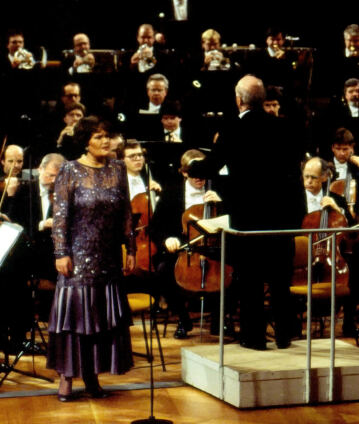Bernard Haitink conducts Mahler’s Second Symphony

Gustav Mahler’s Second Symphony revolves around the great metaphysical questions. At the very beginning a funeral service is evoked before the following movements celebrate the beauty of life and nature. Faith and the resurrection of man characterise the conclusion. Bernard Haitink is the ideal conductor to bring out the sonority and the transcendental aspects of the work.
Each of Gustav Mahler’s symphonies represents a completely independent exploration of the world – in the sense of the composer’s famous motto: “the term ‘symphony’ – to me this means creating a ‘world’ with all the technical means available.” In his Second Symphony, the journey ranges from the “Totenfeier” (funeral rites) – as Mahler once entitled the first movement – to an invocation of the “Resurrection” in the choral finale that first begins pianissimo and a cappella before increasing to its full majestic power. In between, it invokes the beauty of nature and the world of the Wunderhorn songs: in the fourth movement, the Urlicht (Primal Light), originally conceived as a piano song, is heard. The tonal language and structure of the symphony were so radical at the time of its creation that the first performances were met with incomprehension. However, the First is now one of Mahler’s most popular and best-known works.
The Philharmoniker have a particularly close relationship with the symphony: Mahler himself conducted the premiere in Berlin in two phases, as it were: the first complete performance on 13 December 1895 was preceded by a performance of the first three purely instrumental movements. In addition, the orchestra’s first chief conductor, Hans von Bülow, made two significant contributions to the creative process. Mahler played the first movement to his colleague on the piano, which he intended at that time to publish as a single work, as a symphonic poem. Von Bülow is said to have covered his ears several times during the performance, ultimately saying that it made Wagner’s Tristan sound to him like a Haydn symphony. The rejection by his colleague and mentor, in addition to Mahler’s exhausting conducting engagements, may have contributed to the fact that the work was put aside for some time. Mahler was later inspired to complete the symphony at, of all events, the funeral of Hans von Bulow, where a setting of Klopstock’s poem Auferstehn, ja auferstehn wirst du was sung. “The creator waits for this bolt of lightning; this is his ʻHoly Annunciationʼ ”, Mahler commented on the event. He took the first two stanzas of Klopstock, added self-composed verses and used them in the final movement of his symphony.
Over the course of its history, the Berliner Philharmoniker have kept faith with this monumental composition. Chief conductor Arthur Nikisch performed the work in October 1911 on the occasion of a memorial service for the composer, who died half a year earlier. The work was also performed at the orchestra’s first radio broadcast in 1924. Bruno Walter, Otto Klemperer, Lorin Maazel and Seiji Ozawa are among those who conducted performances in Philharmoniker concerts. While Wilhelm Furtwängler only rarely conducted Mahler’s music and Herbert von Karajan did not include the Second in his repertoire, Mahler in general, and the Second Symphony in particular, played a central role for the two following chief conductors, Claudio Abbado and Sir Simon Rattle. The latter had already conducted a performance as a teenager and stressed the strong influence the work had on his decision to become a conductor.
Between the beginning of Abbado’s tenure and the end of Sir Simon’s, only one conductor performed the Symphony with the Philharmoniker: Bernard Haitink, who conducted a performance 1993 as part of his systematic exploration of Mahler with the Philharmoniker. Haitink is considered to be the composer’s true interpreter because he confronts his exuberant world of emotions and sound with structural awareness and an unerring sense for the development of dramatic tension. Haitink approached the symphony with his own patient fidelity and performed the work time and again with the Royal Concertgebouw Orchestra from the 1960s to the 1990s. The perfect prerequisite for his only performance of the work with the Berliner Philharmoniker, which fortunately was documented here.
© 1993 EuroArts Music International, VIDEAL / brilliant media, SFB